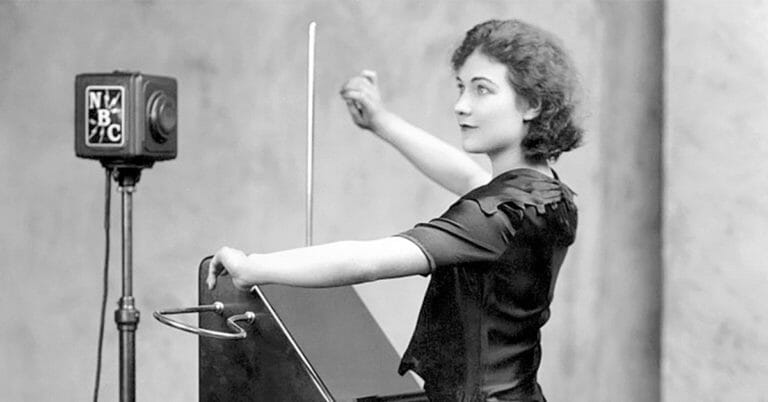By Clare Nina Norelli · May 22, 2018

When we hear the spooky sound of the theremin our mind invariably turns to images that can be found in science fiction and horror films: flying saucers menacing the skies, hostile visitors from other worlds, and cobwebbed mansions haunted by restless phantoms. Owing to its association and overuse within these genres, the theremin’s unsettling frequencies have consequently been relegated to the role of a kooky sound effect and its usage has become a film-music cliché that now seems to generate more amusement than scares. Despite the prevailing associations with Atom Age sci-fi cinema, the theremin has a rich history and its unique timbre has also been utilized in other genres of cinema.
The theremin was invented in 1920 by Russian physicist Léon Theremin and became popular in American high society when its inventor toured the instrument at the end of the decade. Curious socialites attended concerts of classical repertoire being performed on the instrument, most notably by the theremin virtuoso Clara Rockmore. Though never really being embraced as a “serious” instrument, the theremin’s eerie tone—which sounds not unlike an otherworldly female singer—fascinated listeners and it was not long before its unique voice was harnessed by composers for programmatic music. The theremin made its first appearance in cinema in the Russian film Odna (Alone, Leonid Trauberg & Grigori Kozintsev, 1930), scored by the renowned neoclassical composer Dmitri Shostakovich. In the film, the instrument is imitative of the whirling wind of a perilous snowstorm that eventually engulfs Yelena, the film’s lead character.
It wasn’t until the mid-1940s that the theremin began to appear in Hollywood film scores, beginning with Mitchell Leisen’s 1944 musical Lady in the Dark (with a score by Robert E. Dolan). During this period the instrument was used primarily to signify instability, especially in “psychological thrillers” and film noir to emphasize that a character on screen was of unsound mind. Most notable were the scores written by Miklós Rózsa for Spellbound (Hitchcock, 1945) and The Lost Weekend (Billy Wilder, 1945). In these films the theremin is utilized for its destabilizing effect (owing to the inherent dissonance of the instrument’s wavering tone), moaning and shrieking whenever the lead characters are shown suffering a psychological breakdown on screen.
The instrument’s association with sci-fi began with its use in Ferde Grofé’s score for Rocketship X-M (Kurt Neumann, 1950). In this film, the theremin is heard when the crew of the eponymous rocket ship land on alien terrain: it’s almost as if the instrument’s quivering frequencies are emanating from the soil of this strange new world itself. Arguably the best example of this period in sci-fi scoring is the score for The Day the Earth Stood Still (Robert Wise, 1951). Composed by Bernard Herrmann, the score features two theremins amidst a richly orchestrated ensemble featuring brass, vibraphone, organ, harps, pianos and electrified strings. Though the theremin is harnessed for its dramatic capabilities a great deal in this score, the instrument’s beautiful tone is fully explored in Herrmann’s writing, complemented by his other orchestration choices, and not merely exploited as it has been in so many other sci-fi film scores.
Sadly, the theremin has never been able to fully shake its sci-fi roots and be adopted by the mainstream as an instrument worthy of serious study. In cinematic scoring it has predominantly remained an oddity, with matters not being helped by its quirky usage in scores such as those of Tim Burton’s retro-inspired features Ed Wood (1994) and Mars Attacks (1996), written by Howard Shore and Danny Elfman respectively (they are, however, brilliant homages to classic sci-fi scores). On screen the instrument has not fared much better, being used for kooky comical effect in shows such as The Simpsons and American Horror Story, as well as in the film Frank (Lenny Abrahamson, 2014).
Despite the prevailing attitudes to the instrument and its role in film, there are exceptions, such as Marco Beltrami’s thoughtful use of theremin in his rich score for Hellboy (Guillermo del Toro, 2004). The theremin has remained beloved by many musicians and composers, including film composers such as Beltrami, who appreciate what the theremin’s unique character is able to bring to their work.
1 – It has often been reported that Franz Waxman’s score for Bride of Frankenstein (James Whale, 1935) is the first Hollywood film score to use the theremin. However, there seems to be little evidence to support this. The misconception is probably due to the large number of recent recordings and performances of the film’s score that have chosen to employ the instrument.
 Clare Nina Norelli is a composer, musician, teacher and writer. She currently writes Scores on Screen, a column on film music for MUBI’s Notebook and in February of 2017 her first book Soundtrack from Twin Peaks was published as part of Bloomsbury’s 33 1/3 series. You can follow her on twitter @clarenorelli.
Clare Nina Norelli is a composer, musician, teacher and writer. She currently writes Scores on Screen, a column on film music for MUBI’s Notebook and in February of 2017 her first book Soundtrack from Twin Peaks was published as part of Bloomsbury’s 33 1/3 series. You can follow her on twitter @clarenorelli.
For all the latest from The Script Lab, be sure to follow us on Twitter, Facebook, and Instagram.